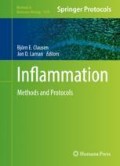Abstract
Solar/ultraviolet (UV) radiation exerts a variety of biological effects, including suppression of the immune system. UV-induced immunosuppression is induced by suberythemogenic/physiological UV doses, and it affects primarily T-cell driven immune reactions. Another characteristic feature of UV-induced immunosuppression is its antigen-specificity. This is due to the induction of T cells with suppressive features, called regulatory T cells. Since UV-induced regulatory T cells may harbor therapeutic potential phenotypic and functional characterization of these cells is ongoing. Most of these studies have been performed in the murine model of contact hypersensitivity. In this protocol we describe a method for the UV-induced suppression of the induction of contact hypersensitivity and the adoptive transfer of immune response.
Access this chapter
Tax calculation will be finalised at checkout
Purchases are for personal use only
References
Schwarz T (2010) The dark and the sunny sides of UVR-induced immunosuppression: photoimmunology revisited. J Invest Dermatol 130:49–54
Toews GB, Bergstresser PR, Streilein JW (1980) Epidermal Langerhans cell density determines whether contact hypersensitivity or unresponsiveness follows skin painting with DNFB. J Immunol 124:445–453
Elmets CA, Bergstresser PR, Tigelaar RE, Wood PJ, Streilein JW (1983) Analysis of the mechanism of unresponsiveness produced by haptens painted on skin exposed to low dose ultraviolet radiation. J Exp Med 158:781–794
Bruder D, Probst-Kepper M, Westendorf AM, Geffers R, Beissert S, Loser K et al (2004) Neuropilin-1: a surface marker of regulatory T cells. Eur J Immunol 34:623–630
Schwarz A, Beissert S, Grosse-Heitmeyer K, Gunzer M, Bluestone JA, Grabbe S et al (2000) Evidence for functional relevance of CTLA-4 in ultraviolet-radiation-induced tolerance. J Immunol 165:1824–1831
Schwarz A, Navid F, Sparwasser T, Clausen BE, Schwarz T (2011) In vivo reprogramming of UV radiation-induced regulatory T-cell migration to inhibit the elicitation of contact hypersensitivity. J Allergy Clin Immunol 128:826–833
Shimizu J, Yamazaki S, Takahashi T, Ishida Y, Sakaguchi S (2002) Stimulation of CD25(+)CD4(+) regulatory T cells through GITR breaks immunological self-tolerance. Nat Immunol 3:135–142
Shreedhar V, Giese T, Sung VW, Ullrich SE (1998) A cytokine cascade including prostaglandin E2, IL-4, and IL-10 is responsible for UV-induced systemic immune suppression. J Immunol 160:3783–3789
Weichenthal M, Schwarz T (2005) Phototherapy: how does UV work? Photodermatol Photoimmunol Photomed 21:260–266
Bruhs A, Haarmann-Stemmann T, Frauenstein K, Krutmann J, Schwarz T, Schwarz A (2014) Activation of the arylhydrocarbon receptor causes immunosuppression primarily by modulating dendritic cells. J Invest Dermatol 135(2):435–444
Navid F, Boniotto M, Walker C, Ahrens K, Proksch E, Sparwasser T et al (2012) Induction of regulatory T cells by a murine beta-defensin. J Immunol 188:735–743
Schwarz A, Navid F, Sparwasser T, Clausen BE, Schwarz T (2012) 1,25-dihydroxyvitamin D exerts similar immunosuppressive effects as UVR but is dispensable for local UVR-induced immunosuppression. J Invest Dermatol 132:2762–2769
Holsapple MP, West LJ, Landreth KS (2003) Species comparison of anatomical and functional immune system development. Birth Defects Res B Dev Reprod Toxicol 68:321–334
Bruhs A, Schwarz T, Schwarz A (2015) Prevention and mitigation of experimental autoimmune encephalomyelitis by murine beta-defensins via induction of regulatory T cells. J Invest Dermatol 136:173–181. doi:10.1038/jid.2015.405
Author information
Authors and Affiliations
Corresponding author
Editor information
Editors and Affiliations
Rights and permissions
Copyright information
© 2017 Springer Science+Business Media LLC
About this protocol
Cite this protocol
Bruhs, A., Schwarz, T. (2017). Ultraviolet Radiation-Induced Immunosuppression: Induction of Regulatory T Cells. In: Clausen, B., Laman, J. (eds) Inflammation. Methods in Molecular Biology, vol 1559. Humana Press, New York, NY. https://doi.org/10.1007/978-1-4939-6786-5_5
Download citation
DOI: https://doi.org/10.1007/978-1-4939-6786-5_5
Published:
Publisher Name: Humana Press, New York, NY
Print ISBN: 978-1-4939-6784-1
Online ISBN: 978-1-4939-6786-5
eBook Packages: Springer Protocols

